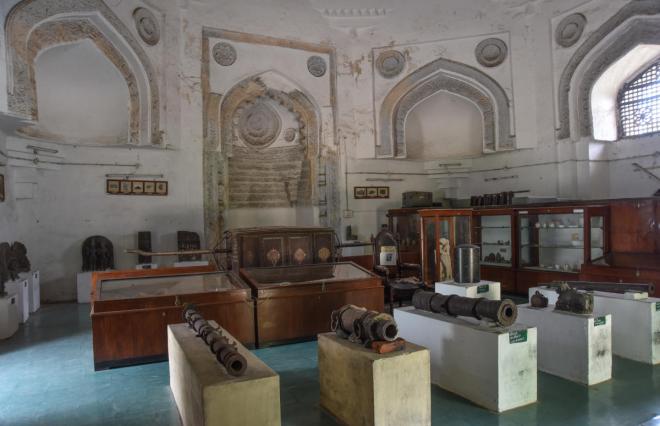The two domed structures in front of the district hospital on Sedam Road can pass off as one of the many historical monuments that dot the city of Kalaburagi. Historical monuments they are, but they also house the Government Museum, which has many sculptures, inscriptions, palm manuscripts, prehistoric artefacts, terracotta figures, beads, coins, cannons, etc. The well-maintained garden adds to the peaceful ambience of the place.
For centuries, Kalaburagi has been a melting pot of religions like Hinduism, Buddhism, Jainism and Islam. Talking about the history of the museum, Shivakumar, archaeological assistant, Department of Archaeology, Museums and Heritage, said that the State government took a decision to establish a museum in Kalaburagi (then Gulbarga) in 1964 to showcase its rich history. Artefacts from different periods of time and representative of various cultures, from the Maurya Empire to the Rashtrakutas, Bahamanis and the Nizam rule are placed here.
The site
“The two empty 15th-century tombs that were in a dilapidated condition were renovated and turned into galleries. The first tomb is situated on the left side of the entrance and is bigger than the second tomb, situated on the right. The third gallery, a newly constructed building, was inaugurated in 1997. The museum has three galleries now,” Shivakumar added.
Sculptures, several hundred years old, have been neatly placed on the platforms on pathways leading to the galleries. Besides, sculptures of tirthankaras, cannons, veeragallus (hero stones), nishidi stones (erected in memory of those who performed sallekhana to attain nirvana); Sati stones and other stones dating from 10th century to 18th century and those from Chalukya, Rashtrakuta, Hoysala and Vijayanagar periods have been neatly placed on platforms around the tombs. While some of the stones are carved from black stone, others are carved from limestone.
The entrance to the first tomb is flanked by two ancient cannons. A few can also be found inside the tomb. Among many idols and sculptures, a beautifully carved Natyashiva, a 12th century Kalyani Chalukya stone panel, is unique. It depicts Lord Shiva dancing with Shivagana, joined by other gods, and is carved on both sides. The sculpture, said to be part of a temple entrance, was found at Kalgi in Chittapur taluk in Kalaburagi district.
Equally beautiful is the 18th-century idol of Goddess Durga, which was found at Sedam. The Jalashayana Vishnu, a 12th-century stone panel found in Kalaburagi, and the idols of Lord Madhusudana and Shiva-Parvati are exhibited here.
The gallery also houses arrow tips and stone tools from the Neolithic era, including terracotta figures and beads, and pottery items sourced from Maski in Raichur. Palm-leaf manuscripts and models of motifs of the Indus valley civilisation are also on display here.
This apart, the gallery houses the porcelain crockery used by Colonel Philip Meadows Taylor, administrator of Surpur in Yadgir district. The collection includes a 20th-century wooden palanquin, swords, armour and a few brass and copper utensils. In the second tomb, a majority of the sculptures and stone panels are carved from limestone and date back to the first and second centuries. They were found during surface excavations in Sannati in Yadgir district and are said to be the remains of a Buddhist stupa.
Most of the sculptures and stone panels, some with inscriptions in Brahmi script, though damaged, speak volumes about the artistic skills of the sculptors from a bygone era as carving is difficult on limestone. The 12th-century black-stone idol of Lord Parshwanatha, a tirthankara, is unique as it has the carving of mango buds. The idol was found at Harasur in Kalaburagi.
Religion & royalty
In the third gallery, sculptures, stone panels and the remains of the Buddist stupa at Sannati are housed, along with a few modern paintings. A stone panel depicting winged animals with a human face bears testimony to the earliest influence of Egyptian and Mesopotamian civilisations on Indian architecture. There are many stone panels that have the carving of the multi-headed snake.
However, most of them are damaged. A fully intact stone Buddha pada (footprint) with intrinsic carving including dharmachakras is a delight to watch. Among the other stone panels, a royal couple seated with horseshoe archway is a unique exhibit. The museum also has a collection of 100 coins from various centuries. Six of them are gold coins from the Vijayanagar period and 44 silver coins are from the Bahmani Sultanate.
source: http://www.deccanherald.com / Deccan Herald / Home> Supplements> Spectrum / by Rakesh Sama, Kalaburagi / DH News Service / December 11th, 2017
